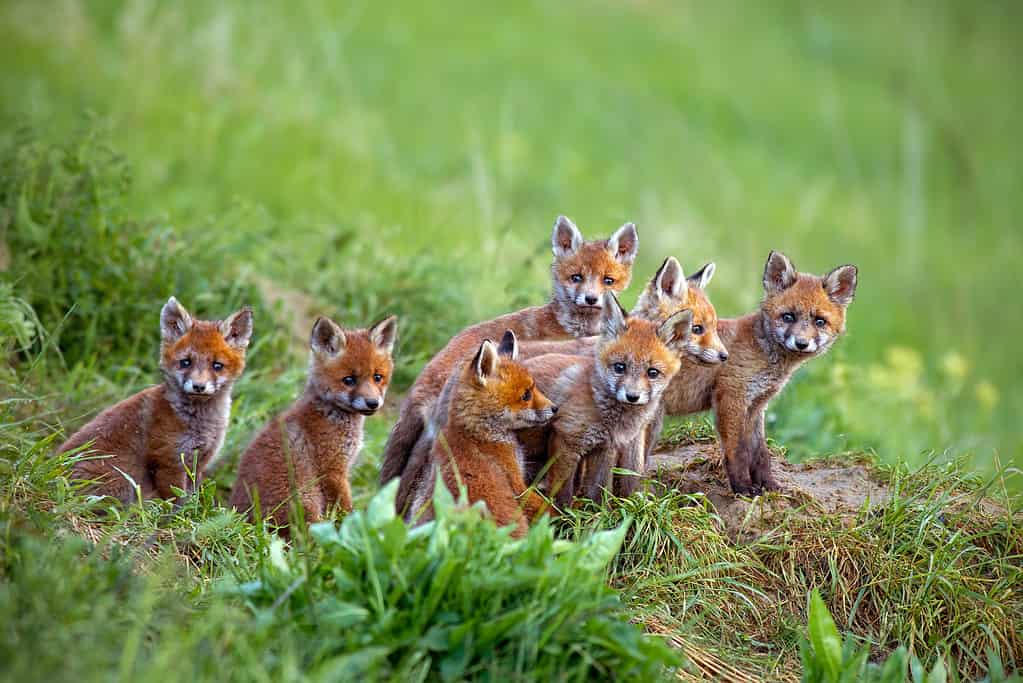What exactly a fox sounds like depends on the species. There are 12 species of “true” foxes worldwide. Each species ranges in size, color, and vocalization.
If you’ve ever heard the 2013 hit song, “The Fox. (What does the fox say?)” by Ylvis, you’ve probably figured out that foxes have a strange set of vocalizations. Still, you probably realized that the “fox” sounds in the song aren’t what foxes really sound like. That may have left you wondering, “What do foxes really sound like?”
Foxes are part of the Canidae family, meaning they are relatives of wolves and dogs. Many of the sounds they make are similar to those of dogs, but others resemble noises more common with cats.
People often have difficulty identifying fox sounds. Identification can often be difficult because foxes are nocturnal. They aren’t an animal we’re used to hearing or seeing often.
They also produce sounds similar to owls, links, and other nocturnal creatures. Many hear foxes but think they are listening to another animal.
Although each fox species may sound somewhat different, they each produce similar sounds.
The fox sounds we are most familiar with come from the red fox (Vulpes vulpes). In 1992, researchers from the University of Bristol identified at least 20 unique fox sounds. Eight of these sounds are unique to fox cubs. Although this study is 31 years old, it still seems to be the most comprehensive study of foxes’ vocalizations.
Below are the 20 most common sounds red foxes make.
Adult Foxes
Full-grown foxes make the most variety of sounds, from barks, to screams, to whines and coughs.
Each fox makes unique vocalizations. Pack members can tell individuals apart by the sound of their calls.

Red foxes can produce over 20 unique vocalizations.
©Mary_wolf88/Shutterstock.com
1. Barks
One of the most common sounds foxes make is a bark similar to a dog’s. Foxes have different sounding barks that each have their own meaning.
One kind of bark is deep and short, similar to a typical dog’s.
Another kind of bark is longer and raspy, almost like they have something stuck in their throat. Researchers think foxes use raspy barks to let other foxes know they are nearby.
Foxes can tell the barks of their pack members from the barks of outsiders. They can use their barks to communicate with family and to tell outsiders to stay away.
2. Yell Barks
These barks sound similar to regular barks. The frequency of the bark drops gradually throughout the second half of the vocalization.
Foxes seem to use these barks most often as “alarm barks.” In other words, they use this bark to alert other foxes of possible threats.
3. Shrieks
Shrieks are all very similar and contain several frequencies. When foxes shriek, they don’t make any other vocalizations. This likely means that foxes use shrieks for a specific reason, but scientists aren’t sure what that is.
Foxes may use shrieks to warn potential predators to stay away since the sound is quite alarming. There are many larger animals that prey on foxes, like bears, wolves, coyotes, and eagles.
4. Whines
Whines sound just like you’d expect — very similar to a dog’s whine.
Researchers say that foxes mostly whine after barking. These sounds are high-pitched at the beginning but lose their frequency at the end.
Foxes probably whine for the same reasons dogs do. They may whine from frustration or because they want attention from other foxes. Foxes may also whine to greet another fox or to submit to a more dominant one.
Mother foxes often use whines and whimpering with their pups to calm them down and make them feel safe.
5. Ratchet Calls
These types of calls vary greatly and sound a lot like raucous bird calls.
The males most often use these calls during mating season when they’re fighting with each other for a mate.
Ratchet calls contain many parts, which makes them difficult for researchers to identify. Scientists have given ratchet calls many different names, including “snirks,” “clickerting,” gekkering,” or “clicketing.”
6. Staccato Barks
These kinds of barks are short with varying pitches.
Scientists believe foxes use these barks to keep tabs on one another from long distances.
7. “Wow-Wow” Barks
These barks are longer than staccato barks and often contain many barks in quick succession. Some say these barks sound similar to ducks quaking.
Foxes likely use these barks to claim their territory when other foxes are around.
Male foxes sometimes use it to let their mates know they’ve left them food at the door of their den.
Some researchers say that foxes use “wow-wow” barks to greet members of their pack.
“Wow-wow” barks are also commonly used by parents when letting their cubs know it’s safe.
8. Yodel Barks
Yodel barks get their name because they sound much like yodeling.
These barks are quieter and less shrill than other barks. The rising and falling of the bark’s pitch moves quickly, resembling yodeling.
9. Growls
Like dogs, foxes produce long, low growls when warning another creature. The sound is meant to be a threat, often telling other animals to stay out of the fox’s territory.
10. Coughs
Like growls, coughs are long and low sounds but far less threatening.
Female foxes usually cough at their cubs to communicate with them.
Although the coughs all sound the same to us, the cubs seem to be able to distinguish them quite easily and respond to them.
11. Screams
One of the most well-known sounds a fox makes is an eerie, high-pitched scream.
Scientists think female foxes, called vixens, use this kind of vocalization to attract mates.
The sound of a fox howling is so alarming that it scares many people who have never heard it before.
The shrill sound of the scream genuinely sounds like a woman screaming. Imagine hearing the below scream in the middle of the dark woods while you’re camping.
12. Yell Whines
These kinds of whines sound much like typical whines, though they are much louder.
Sounds that Cubs Make

Red fox cubs produce murmurs and warbles that adults can’t copy.
©JMrocek/ via Getty Images
The two calls that are truly unique to cubs are murmurs and warbles. The other six sounds that cubs make are similar to those of adults.
13. Murmurs
Newborn cubs mostly make murmuring sounds. These random vocalizations are high-pitched at first but drop in frequency.
Murmurs typically only last about one second.
Cub murmurs sound similar to adult whines.
14. Warbles
These sounds are another kind of murmuring common in cubs around two to three weeks old.
Warbles are a combination of many different sounds.
The vocalizations gradually change into barks and other adult sounds as the fox ages.
15. Mimicking Adults
Cubs make six other sounds that mimic those of adult sounds.
These sounds include the following:
- Whines
- Ratchet Calls
- Wow-wow barks
- Growls
Do Foxes Laugh?
There are many videos online of foxes laughing. Still, the sound is rarely mentioned as a “normal” fox sound.
Interactions with domesticated foxes show that pet foxes will make laugh-like sounds when they are happy or excited.
“Laughing” is not considered a natural sound, and it’s unlikely for wild foxes to produce this sound.
Other Foxes
The bat-eared fox gets its name from its massive ears.
These foxes have nine known vocalizations. Seven of these sounds are low-pitched, and the foxes use them in pack settings.
The other two sounds are higher-pitched. Foxes use them when scared or alerting other foxes of danger.
Fennec foxes are another kind of giant-eared fox that lives in the deserts of northern Africa.
These foxes produce many of the same sounds as red foxes. Some sounds include chatters, squeaks, whimpers, barks, howls, and growls.
Summary of the Sounds Foxes Make
| Sound | What It Means |
|---|---|
| Barks | Identification and communication |
| Yell Barks | Alarm barks |
| Shrieks | Unknown — possibly to scare off predators |
| Whines | Frustration, attention, greeting, submission |
| Ratchet Calls | Males fighting for mates |
| Staccato Barks | Communication over long distances |
| “Wow-wow” Barks | Communication and claiming territory |
| Yodel Barks | Communication |
| Growls | Warning |
| Coughs | Communication with cubs |
| Screams | Mating calls |
| Yell Whines | Frustration, attention, greeting, submission |
| Murmurs | Newborn communication |
| Warbles | Young pup communication |
The photo featured at the top of this post is © Mary_wolf88/Shutterstock.com
Thank you for reading! Have some feedback for us? Contact the AZ Animals editorial team.







